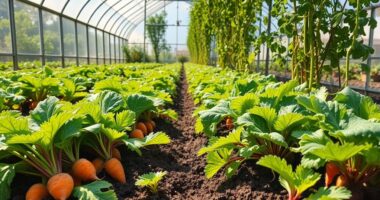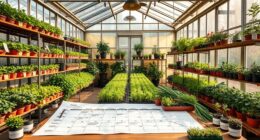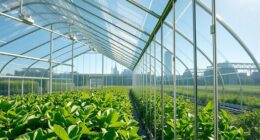In your greenhouse, growing vines and climbers can create a stunning and lively space. You've got options like fragrant Clematis and vibrant Passion Flowers. Consider their climbing mechanisms, like twining stems and tendrils, to choose the best support structures, from trellises to decorative obelisks. Remember to maintain the right temperature, humidity, and soil conditions for ideal growth. As you cultivate these plants, you'll discover their many benefits and perhaps some popular edible varieties worth trying.
Key Takeaways
- Select climbing plants like Clematis Armandii and Passion Flower for vibrant flowers and fruit production in your greenhouse.
- Use appropriate support structures like trellises and pergolas to encourage healthy vine growth and maximize space.
- Ensure optimal environmental conditions, including temperature, light intensity, and humidity, for thriving climbing plants.
- Maintain well-draining soil and adequate CO2 levels to support healthy moisture levels and enhance growth.
- Enjoy the benefits of climbing plants, such as improved air quality, energy efficiency, and increased garden aesthetics.
Types of Climbing Plants for Greenhouses
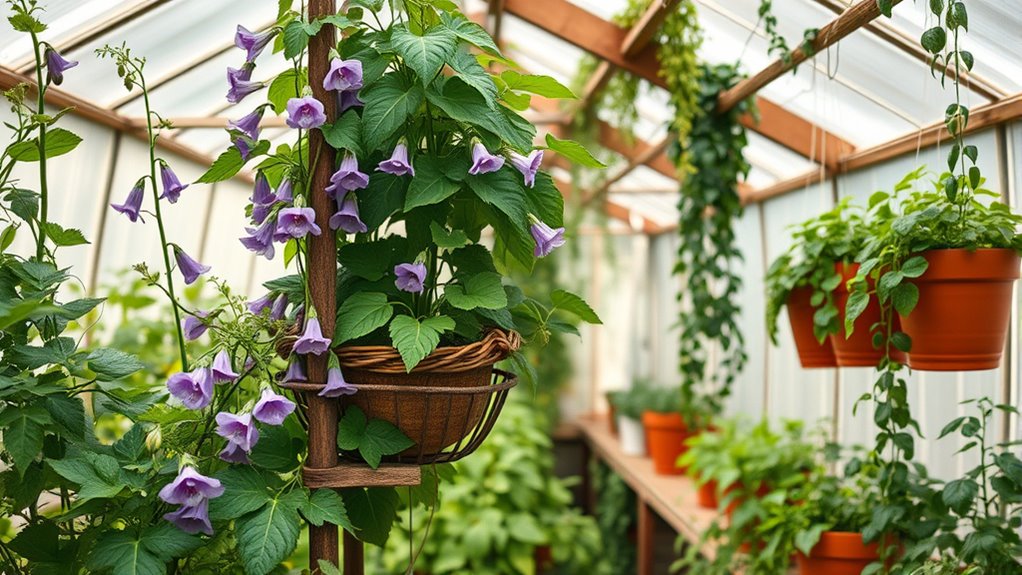
When you're planning a greenhouse garden, choosing the right climbing plants can greatly enhance both the aesthetics and productivity of your space.
Consider Clematis Armandii for its fragrant white flowers and glossy leaves, perfect for a sunny spot. If you need something versatile, Persian Ivy thrives in both sun and shade with its striking variegated foliage.
Clematis Armandii offers fragrant blooms for sunny spots, while Persian Ivy thrives in varied light with striking foliage.
For more blooms, try Passion Flower, showcasing unique blue and white flowers and even fruits in summer. Melon Plants and Grape Vines are fantastic for producing delicious fruits, while Hoya adds charm with waxy star-shaped flowers.
Don't overlook the Maidenhair Vine, which brings delicate foliage, thriving in partial shade. Each option contributes to a vibrant and fruitful greenhouse environment.
Climbing Mechanisms: How Vines Attach

Climbing plants have fascinating ways of attaching themselves to supports, making them unique additions to your greenhouse garden.
Twining stem climbers, like honeysuckle, wrap their stems around supports using thigmotropism. Grasping leaf stem climbers utilize their leaf stems to latch onto thin structures, while aerial root climbers, such as poison ivy, use roots to cling to surfaces.
Tendril climbers, like grapes, have specialized tendrils that coil around various supports. In conclusion, adhesive disk climbers, like Virginia creeper, employ small pads to stick to smooth surfaces.
Each mechanism helps these vines reach new heights, adapt to their surroundings, and thrive in your greenhouse environment. Understanding these attachment methods can enhance your gardening experience.
Choosing the Right Support Structures
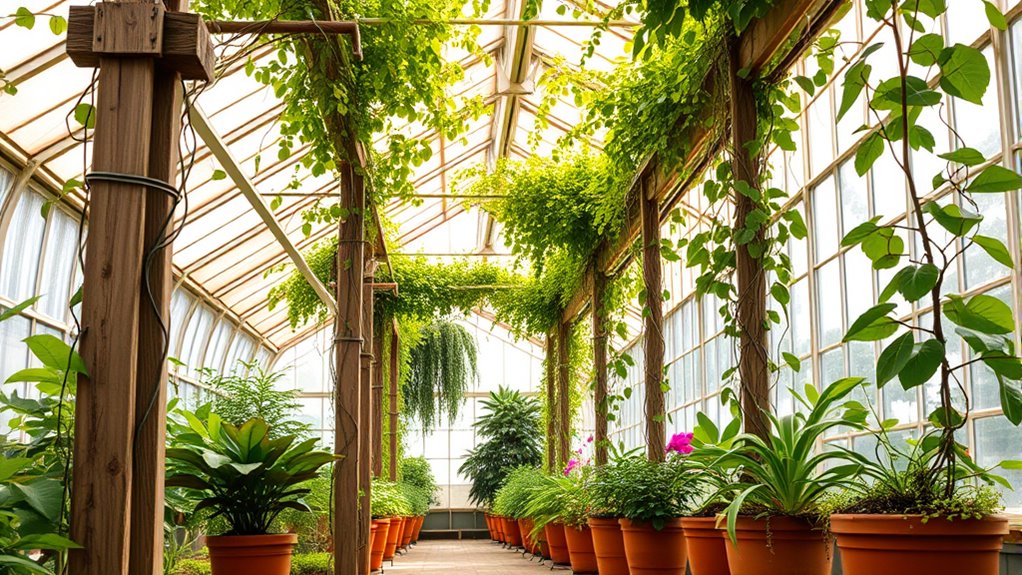
Understanding how climbing plants attach to supports opens the door to choosing the right structures for your greenhouse garden.
Start with simple stakes for individual plants, or utilize existing fences for a cohesive look. Trellises offer great latticework, while pergolas can create lush, covered areas. Consider decorative obelisks for containers or beds. Regular maintenance of these structures can help prevent deterioration and ensure your climbing plants thrive. Additionally, proper priming of your supports can enhance the longevity of materials used in your greenhouse. Backyard greenhouses can create an ideal environment for these plants, allowing for optimal growth conditions and extended gardening seasons.
When it comes to materials, wood is traditional, but metal, bamboo, and plastic each have unique benefits. Placement is essential—ensure adequate airflow, maximize sun exposure, and keep maintenance easy. Don't forget aesthetics; choose structures that enhance your garden's beauty.
Finally, think about customization and versatility, as bespoke supports or adjustable systems can meet your specific needs effectively. Utilizing custom support structures can enhance the overall functionality and design of your greenhouse garden.
Environmental Considerations for Successful Growth
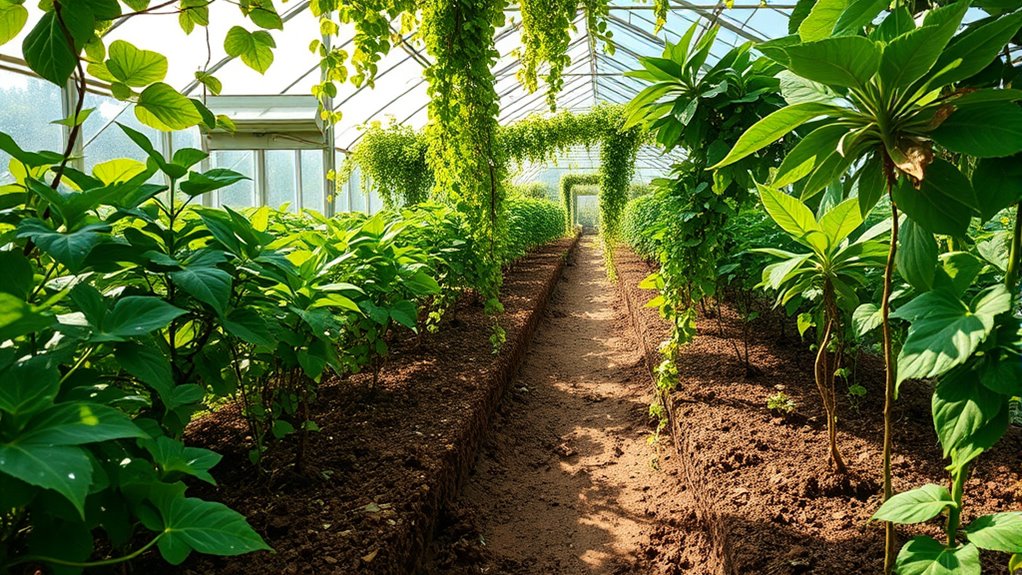
While your greenhouse garden thrives, several environmental factors play an essential role in guaranteeing successful growth.
The best temperature for grapevines lies between 77°F and 90°F, with warm days and cooler nights promoting development. Monitor temperatures closely to prevent extreme fluctuations that can harm your plants.
High light intensity, especially in spring, boosts grape production, so consider using artificial lighting if natural light is insufficient.
Ascertain well-draining soil for proper moisture levels, as frequent watering is necessary in greenhouses.
Maintain humidity to avoid fungal diseases, employing good ventilation and air circulation.
Finally, keep an eye on CO2 levels, as enrichment greatly enhances growth and yield.
Training and Maintaining Your Vines

To guarantee your grapevines flourish, it's important to implement effective training and maintenance techniques.
Start by selecting a training system that suits your environment—options like the Cordon Method or Guyot System can enhance fruit quality. For young vines, staking is necessary to develop a straight trunk.
Regular pruning is essential; use spur pruning in warmer climates and cane pruning in cooler areas to promote new growth. Monitor your vines for pests and diseases, and make sure they receive adequate sunlight and nutrients.
Consider employing trellis systems for structural support, and don't hesitate to adapt your approach as your vines mature.
Benefits of Growing Climbing Plants

Growing climbing plants offers a multitude of benefits that enhance both your garden and your well-being.
These plants act as natural air purifiers, absorbing harmful pollutants while providing shade that reduces your home's energy consumption.
With their vibrant foliage and flowers, climbing plants beautify your space and create dynamic patterns, adding visual interest to your garden.
They also support local wildlife, offering food and shelter for beneficial insects and birds, which contribute to a balanced ecosystem.
Additionally, being around these plants can lower stress levels and boost your mood, promoting mental well-being.
Popular Edible Vines for Greenhouse Cultivation

Edible vines can transform your greenhouse into a lush and productive space, offering a variety of flavors and textures.
Consider growing Choko, a fast-growing plant that can substitute for potatoes or apples in recipes. Malabar Spinach thrives in warmer climates, delivering succulent leaves. The high fiber content of Chia Seeds can complement the nutritious value of the dishes prepared with these greens. Additionally, chia seeds are a complete protein source, making them an excellent addition to any meal. Chia seeds can also be used to create health-boosting recipes that incorporate these edible vines for added nutrition.
Scarlet Runner Beans regrow each year, while grapes provide shade in summer and sunlight in winter. If you're looking for colorful options, the Butterfly Pea offers edible flowers. For vertical gardening, try Hops Vine for its nutritious shoots or Passionfruit for its sweet fruit.
Kiwi Berries are perfect for containers, and Nasturtium adds a peppery taste. Additionally, incorporating omega-3 rich seeds like chia seeds into your meals can enhance the nutritional value of dishes made with these edible vines.
These vines not only maximize space but also enhance your culinary experience right from your greenhouse!
Frequently Asked Questions
What Are the Best Vine Varieties for Beginners?
If you're starting with vines, consider clematis for its stunning flowers and simplicity.
Honeysuckle's fragrant blooms are easy to maintain, making it another great option.
Grapevines offer both beauty and fruit, while wisteria adds cascading elegance.
Passionflower boasts intricate blooms and low maintenance needs.
These varieties not only thrive with minimal effort but also bring vibrant life to your garden, making them perfect for beginners like you.
How Can I Prevent Pests on My Climbing Plants?
You might picture your climbing plants thriving in a vibrant garden, but pests can quickly shatter that dream.
To prevent them, start by keeping your space clean and removing debris. Quarantine new additions before introducing them. Use fine mesh screens to block pests and maintain healthy soil to boost plant immunity.
Regularly inspect your plants and consider introducing beneficial insects like ladybugs to keep pest populations in check. Your plants will thank you!
When Is the Best Time to Plant Climbing Vines?
The best time to plant climbing vines depends on your region.
If you're in a cold area, spring is ideal for bare-root vines after the last frost.
In warmer climates, autumn allows roots to establish before winter.
For container-grown climbers, you can plant them year-round, ensuring you provide proper care.
Always consider local climate conditions, as timing can vary based on microclimates and specific vine types you're working with.
Can Climbing Plants Survive Indoors Year-Round?
Imagine your home as a cozy castle, where climbing plants are the brave vines scaling its walls.
Yes, these resilient plants can thrive indoors year-round, but you've got to be their loyal caretaker.
Provide them with bright, indirect light, maintain a stable temperature, and keep humidity consistent.
With a little love and attention—like watering wisely and offering support—they'll flourish, turning your castle into a lush, green sanctuary all year long.
What Fertilizers Are Best for Climbing Plants in Greenhouses?
When choosing fertilizers for climbing plants in greenhouses, you'll want to contemplate balanced formulas like 15-15-15 for overall growth.
Specialized options, such as Clematis and Climbers Food, promote root and flower development.
Don't forget about liquid feeds for consistent nourishment, and slow-release varieties can save you time.
Organic options, like fish and kelp extracts, are also great choices.
Always monitor your plants' responses to adjust your fertilization strategy effectively.
Conclusion
In greenhouse gardening, nurturing climbing plants can turn your space into a lush paradise. Remember, "What grows together, goes together." By selecting the right vines, providing proper support, and maintaining their health, you'll enjoy a thriving garden that not only beautifies but also offers delicious rewards. Embrace the journey of growth, and watch as your vines flourish, creating a vibrant tapestry that enriches your greenhouse experience. Happy gardening!




